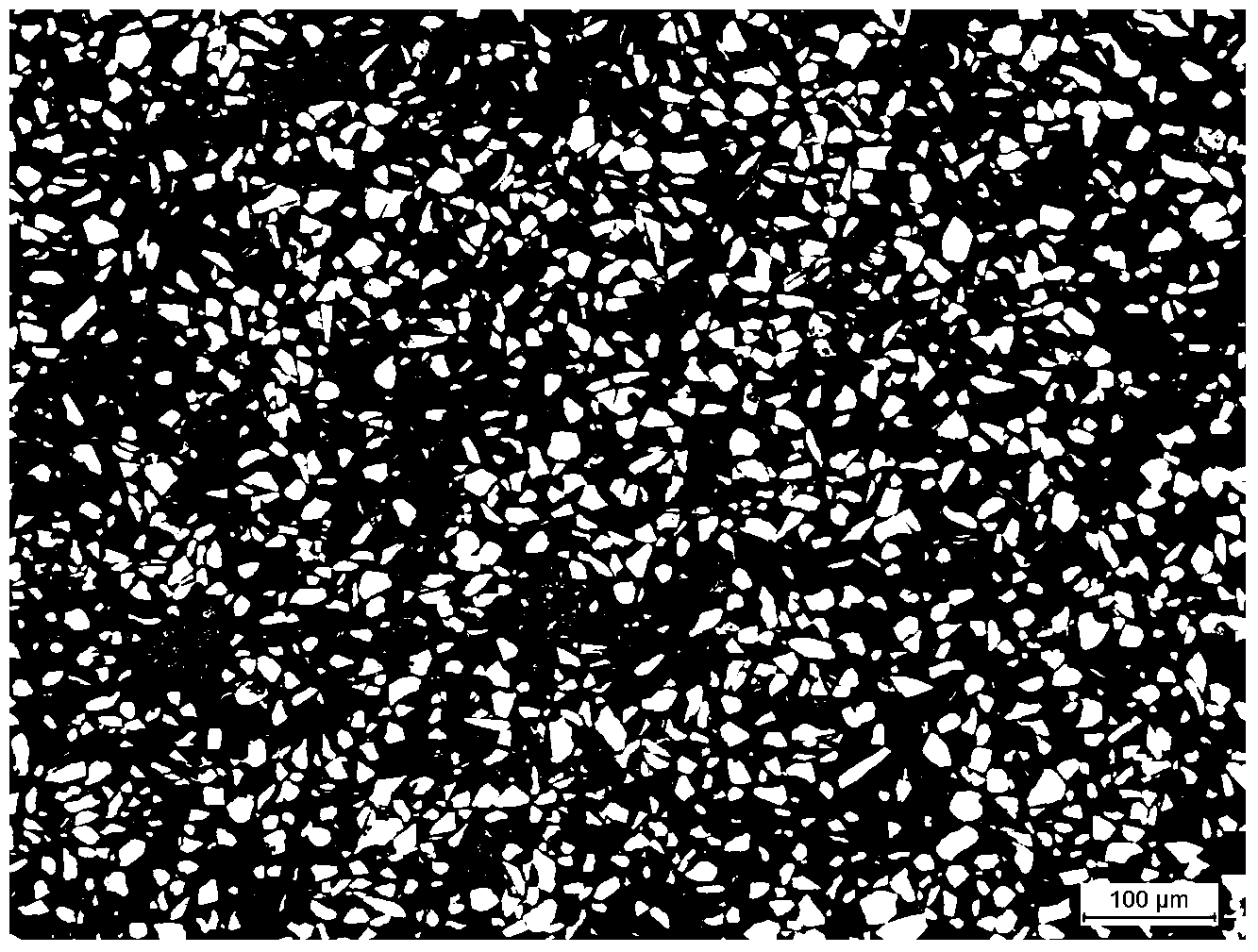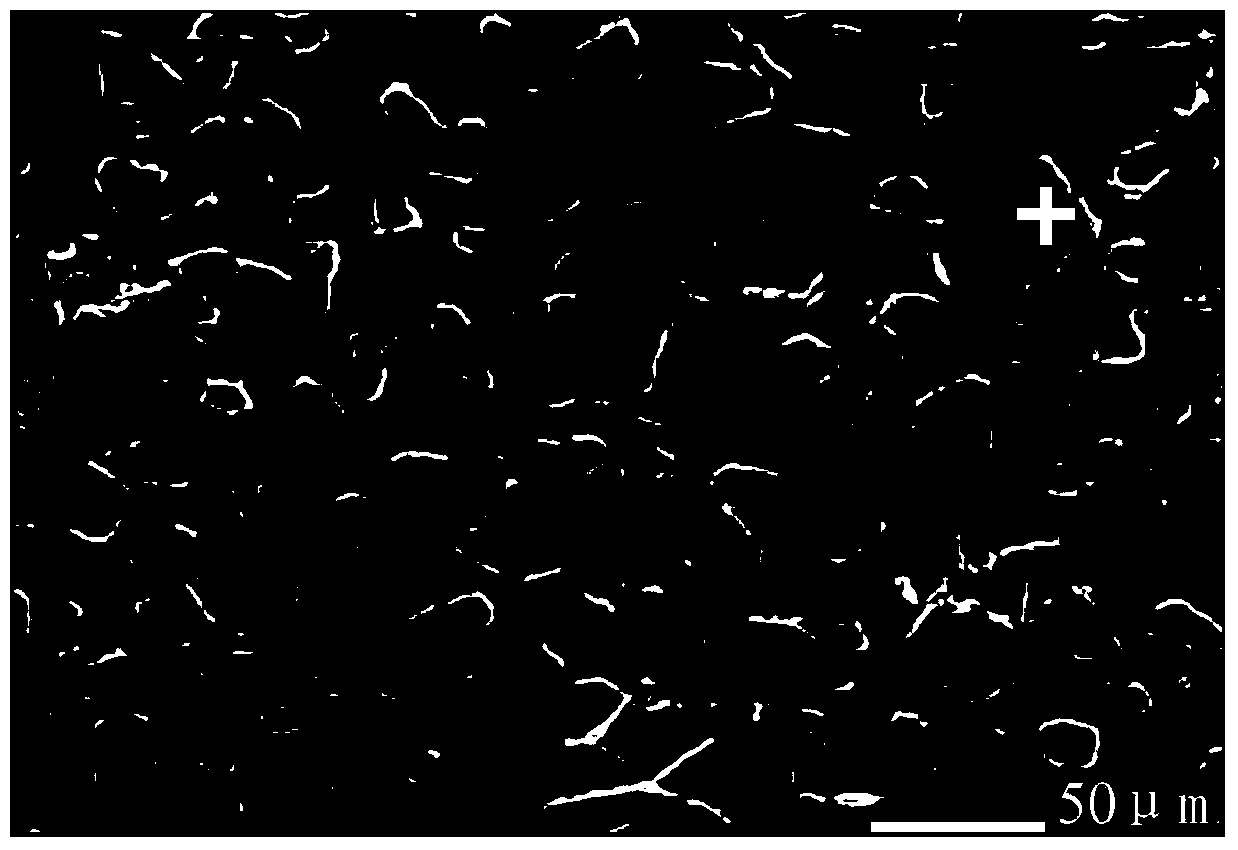Ceramic particle enhanced magnesium-based composite material and preparation method thereof
A composite material and ceramic particle technology, applied in the field of materials, can solve the problems of reduced infiltration rate, increased process cost, poor wettability, etc., and achieves the effects of improved wear resistance, improved wettability, and enhanced strength
- Summary
- Abstract
- Description
- Claims
- Application Information
AI Technical Summary
Problems solved by technology
Method used
Image
Examples
Embodiment 1
[0039] A preparation method of ceramic particle reinforced magnesium-based composite material, the steps are as follows:
[0040] 1. Take B with an average particle size of 28 μm 4 C powder, Ti powder with an average particle size ≤ 25 μm and binder liquid natural rubber are mechanically mixed to obtain a mixed powder; wherein, the amount of Ti powder is Ti powder and B 4 8% of the total volume of C powder, the amount of binder is Ti powder and B 4 5% of the total volume of powder C;
[0041] 2. Use a press to cold-press the mixed powder into a ceramic prefabricated block with a density of 60%;
[0042] 3. Take a pure magnesium ingot with the same size as the ceramic prefabricated block, put the two into the graphite mold, the magnesium ingot is located above the ceramic prefabricated block, and the size of the contact surface between the two is the same;
[0043] 4. Put the graphite mold equipped with ceramic prefabricated blocks and magnesium ingots into the constant temp...
Embodiment 2
[0047] A preparation method of ceramic particle reinforced magnesium-based composite material, the steps are as follows:
[0048] 1. Take B with an average particle size of 10 μm 4 C powder, Ti powder with an average particle size ≤ 25 μm and binder liquid natural rubber are mechanically mixed to obtain a mixed powder; wherein, the amount of Ti powder is Ti powder and B 4 7% of the total volume of C powder, the amount of binder is Ti powder and B 4 8% of the total volume of powder C;
[0049] 2. Use a press to cold-press the mixed powder into a ceramic prefabricated block with a density of 55%;
[0050] 3. Take a pure magnesium ingot with the same size as the ceramic prefabricated block, put the two into the graphite mold, the magnesium ingot is located above the ceramic prefabricated block, and the size of the contact surface between the two is the same;
[0051] 4. Put the graphite mold equipped with ceramic prefabricated blocks and magnesium ingots into the constant temp...
Embodiment 3
[0055] A preparation method of ceramic particle reinforced magnesium-based composite material, the steps are as follows:
[0056] 1. Take B with an average particle size of 5 μm 4 C powder, Ti powder with an average particle size ≤ 25 μm and binder liquid natural rubber are mechanically mixed to obtain a mixed powder; wherein, the amount of Ti powder is Ti powder and B 4 6% of the total volume of C powder, the amount of binder is Ti powder and B 4 10% of the total volume of powder C;
[0057] 2. The mixed powder is unidirectionally cold-pressed into a ceramic prefabricated block with a density of 50% by a press;
[0058] 3. Take a pure magnesium ingot with the same size as the ceramic prefabricated block, put the two into the graphite mold, the magnesium ingot is located above the ceramic prefabricated block, and the size of the contact surface between the two is the same;
[0059] 4. Put the graphite mold equipped with ceramic prefabricated blocks and magnesium ingots into...
PUM
| Property | Measurement | Unit |
|---|---|---|
| density | aaaaa | aaaaa |
| density | aaaaa | aaaaa |
| density | aaaaa | aaaaa |
Abstract
Description
Claims
Application Information
 Login to View More
Login to View More - R&D
- Intellectual Property
- Life Sciences
- Materials
- Tech Scout
- Unparalleled Data Quality
- Higher Quality Content
- 60% Fewer Hallucinations
Browse by: Latest US Patents, China's latest patents, Technical Efficacy Thesaurus, Application Domain, Technology Topic, Popular Technical Reports.
© 2025 PatSnap. All rights reserved.Legal|Privacy policy|Modern Slavery Act Transparency Statement|Sitemap|About US| Contact US: help@patsnap.com



